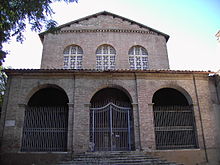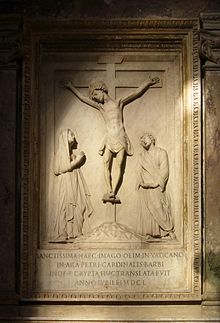Santa Balbina all'Aventino
Santa Balbina ( Italian Santa Balbina all'Aventino ; Latin Titulus Sanctae Balbinæ ) is a titular church in Rome , located in the XXI. Rione San Saba on the Aventine above the Caracalla Baths ; the entrance can be reached via Via Baccelli.
Patronage
Possibly the church goes back to the Titulus Tigridae , which is mentioned in 499 at the Synod of Symmachus , but is otherwise unknown. The Titulus Sanctae Balbinae is first mentioned in the acts of the Council of 595. Since the 6th century the relics of St. Balbina had been transferred from Rome to this church, it was consecrated in this name. The church is probably a foundation by a Roman woman named Balbina, who was later made title saint.
Building history
It is believed that the first early Christian church was set up as early as the 5th century in an apsidal hall that had belonged to the town villa of the consul and town prefect Lucius Fabius Cilo ( domus Cilonis ) built after 350 . This hall is a longitudinal, single-nave hall (approx. 24 × 15 m) under an open roof, which ends with a semicircular apse to the west. Characteristic of the construction period are the side walls, which are loosened up by six alternating semicircular and square niches with arched windows above. The buildings of Sant'Adriano at the Roman Forum and Santi Quirico e Giulitta are comparable . The conversion into a church took place without any structural changes; only the vestibule with the three broad arches was added.
Interior
The valuable wall paneling of the apsid hall from the 4th century seems to have been preserved after the conversion to a church. The abundance of light through the numerous large-format windows in the nave and apse was also remarkable . A mosaic is said to have been present in the apse of the early Christian church ; according to records from the 17th century it could have been a representation of Christ with the apostles. The mosaic floor made from reused remains of ancient buildings has been preserved. The wall grave of Stefano de Surdis (d. 1303) at the church entrance was created and signed by Giovanni di Cosma (1296–1303); the bishop's throne in the apse is also a cosmatic work . The tomb of Pope Paul II (1464–1471), a marble relief of Jesus on the cross with Mary and John, was made by Mino da Fiesole (1431–1484). The fresco in the apse with the glorification of St. Balbina painted Anastasio Fontebuoni (1599).
Between 1927 and 1930 Antonio Muñoz restored the church to the condition it was in before the major restoration of 1571. The current design of the facade also comes from him. Stefan Váncza (István Báncsa), the first Hungarian cardinal , is buried in the church.
Next to the church is a monastery complex that was originally inhabited by Greek monks and has served as a nursing home since 1897.
Cardinal priest
literature
- Hugo Brandenburg : The early Christian churches in Rome from the 4th to the 7th century. Schnell & Steiner, Regensburg 2013, p. 234ff.
- Hans Georg Wehrens: Rome - The Christian sacred buildings from the 4th to the 9th century - A Vademecum . Herder, Freiburg 2016, pp. 265f.
- Anton Henze u. a .: Art guide Rome . Reclam, Stuttgart 1994, p. 155.
- Walther Buchowiecki : Handbook of the Churches of Rome. The Roman sacred building in history and art from early Christian times to the present. Volume 1, Hollinek, Vienna 1967, p. 424ff.
Individual evidence
- ↑ Hugo Brandenburg: The early Christian churches in Rome from the 4th to the 7th century , Regensburg 2013, p. 234.
- ↑ Lexicon for Theology and Church, Freiburg 2006, Volume 1, Sp. 1364f.,
- ↑ Hans Georg Wehrens: Rome - The Christian Sacred Buildings from the 4th to the 9th Century - Ein Vademecum , Freiburg 2016, p. 265f. with floor plan Fig. 36.1.
- ↑ Walther Buchowiecki: Handbook of the Churches of Rome. The Roman sacred building in history and art from early Christian times to the present. Volume 1, Vienna 1967, p. 425f.
- ^ Claudio Rendina: Le Chiese di Roma . Newton & Compton, p. 42, Rome 2007, ISBN 978-88-541-0931-5 .
- ↑ Bancsa, István. In: Salvador Miranda : The Cardinals of the Holy Roman Church. ( Florida International University website ), accessed July 22, 2016.
- ↑ Istituto Santa Margherita ( Memento of the original from March 19, 2016 in the Internet Archive ) Info: The archive link was inserted automatically and has not yet been checked. Please check the original and archive link according to the instructions and then remove this notice.
Web links
Coordinates: 41 ° 52 ′ 49.9 " N , 12 ° 29 ′ 22.8" E



